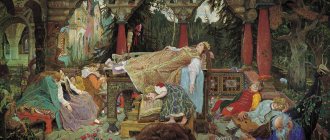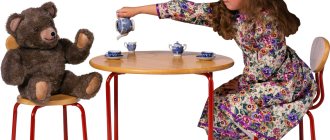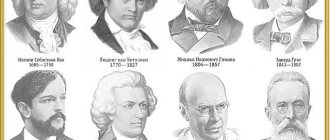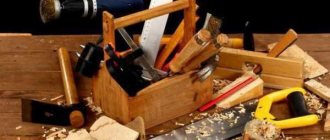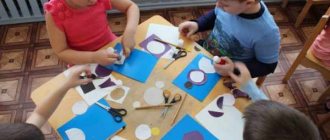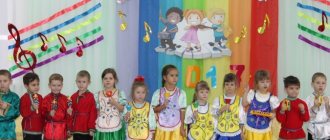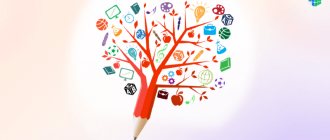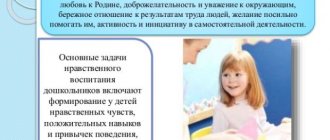“Innovative approaches in music education and development of preschool children”
Author: Kucher Lyudmila Petrovna
Musical director of MBDOU "DS" Solnyshko"
“Innovative approaches in music education and development of preschool children”
Innovative approaches in music education and development of preschool children.
“Music inspires the whole world,
supplies the soul with wings, promotes
flight of imagination; music gives life
and joy to everything that exists...
it can be called an incarnation
everything beautiful and everything sublime"
Music occupies a special, unique place in the education of preschool children. This is explained by the specifics of this type of art and the psychological characteristics of preschoolers. Music is called the “mirror of the human soul”, “emotional cognition” (B.M. Teplov), “model of human emotions” (V.V. Medushevsky): it reflects a person’s attitude to the whole world, to everything that happens around and in itself person. Primary musical education is designed to play a very important role in a person’s life.
The work of a music director in a preschool educational institution at the present stage is filled with new content - to raise a person capable of independent creative work, an active, searching person. Music is a source of special children’s joy, and the use of various pedagogical methods in music classes solves the most important task of early musical education - the formation of the leading component of musicality - the development of emotional responsiveness to music. When carrying out GCD, children develop the ability to perceive, feel, understand the beauty in life, art, and become involved in artistic and creative life. Therefore, I consider the goal of my work to be to ensure that every child develops musical communication and creative abilities, and strengthens mental and physical health.
Changing life around us dictates that modern teachers need to choose more effective means of teaching and education based on modern methods and new integrated technologies.
The use of innovative methods, forms and technologies in music education under the conditions of the introduction of the Federal State Educational Standard became the goal of my work.
I implement the goal in tasks that meet the urgent needs of the child:
- creating conditions that provide opportunities for each child to demonstrate their individual abilities when communicating with music;
- creative development of the child’s natural musicality;
- creating conditions for spontaneous creative manifestations.
The main principle that guides my work is attention to each child: taking into account his age, speech, individual musical characteristics and needs. There are a number of other principles that I adhere to in music classes:
- The musical director is an equal partner. He knows how to play interestingly and show creativity.
- Gives children the right to choose a musical repertoire, knowledge, skills,
- Focuses on the individual capabilities and abilities of children.
Integrated musical activity becomes the norm of musical life in kindergarten, as in my work. The purpose of this type is to give children an idea of the specifics of various types of art (music, painting, theater, choreography, poetry), the expressive features of their artistic means, the ability to convey thoughts and moods in different types of artistic activity of children in their original language.
The success of work on the musical development and education of children is impossible without the joint work of the music director and educators, whose work is aimed primarily at preserving the health of children. Health preservation is becoming a priority in the work of our preschool educational institution and many others. Science has proven that musical development is inextricably linked with the physical well-being of a child. Singing develops the vocal apparatus, speech, strengthens the vocal cords, and regulates children's breathing. Rhythm improves a child’s posture, coordination, confidence and plasticity of movements. Playing instruments develops a sense of rhythm, the ability to play alone and in an ensemble. All types of GCD contribute to solving the following problems:
- Preservation and promotion of children's health;
- Development of sensory and motor functions.
- Formation of the need for physical activity;
- Acquiring the skill of proper breathing;
5.Development of intellectual functions (thinking, memory, imagination, attention, perception, spatial orientation, etc.);
- Development of the emotional-volitional sphere and gaming activity;
- Formation of a harmonious personality.
Using the computer allows me to enliven joint educational activities with children. Computer techologies
expand the opportunity to present musical and didactic material provided for in the educational program of a preschool institution.
Using ICT
In musical educational activities, in my opinion, the cognitive interest of preschoolers in music began to intensify, children's attention intensified, as new motives for mastering the proposed material appeared, children became more active in the joint discussion of a musical work. Musical activity has become more meaningful, harmonious and productive.
The basis of innovative technologies for musical education of children is collective activity, combining: singing, rhythmic speech, playing children's musical instruments, dancing, improvised movement to music, voicing poems and fairy tales, pantomime, improvised theatrical performance.
The forms of musicality development that I use in practice are:
Communicative dances.
Involving a child in the process of playing music lies through creating an atmosphere of acceptance of each other and emotional and mental emancipation. Here, communicative dances are indispensable assistants, the use of which solves the following problems:
- development of communication skills,
- working on the sense of form,
- development of motor coordination,
- developing a sense of rhythm.
Finger games (musical and speech).
The value of finger games in the context of the development of children's musicality lies in the fact that they represent the first experiences of performing artistry. Finger games:
- develop the muscular system, fine motor skills, tactile sensitivity;
- increase the overall level of organization of the child;
- are aimed at developing a sense of rhythm, expressive speech intonation, and coordination of movements.
Rhythmic recitation to music
– synthesis of music and poetry. It can be defined as a musical pedagogical model in which the text can be sung and rhythmically recited. For example, the poem “April” by S. Marshak.
Carl Orff technique
opens up a wonderful world of sounds for children: the music of rain, sun, wind, icicles, snowflakes. Children develop skills of improvisation, imagination, and independent creativity. The educational activities I conducted on the topic “Autumn Mood”, “Winter Fantasy”, “Journey to the Spring Forest” contributed to the development of a sense of rhythm, creativity in playing musical instruments and free dancing, and to hear the “music of nature” through the perception of music.
Design method
The modern method of integrating activities allows you to solve a set of problems subordinated to one topic. The method is relevant and very effective. It gives the child the opportunity to synthesize acquired knowledge, develop creativity and communication skills. In addition, project-based activities allow children to develop research skills and cognitive interest.
Theme of patriotism
is relevant and significant in the work of our kindergarten.
I pay special attention to this topic, because it teaches children kindness, generosity, love for their Motherland and native land, respect for their parents and each other. Children participate in festive and folklore events, learn a lot about folk traditions: “ Old people, young at heart
”;
«My land is northern Yamal";
“In the friendship of the Nars is the unity of Russia”;
“ Warmth
of hearts for beloved mothers”;
“ Tsvetik - seven-colored” - Family Day and others.
The innovative technologies that I use in my work are focused on the full development of the child as an individual, on the desire to help him enter the modern world and join its values. An analysis of the work shows that the method of integration and variability in the use of innovative programs and technologies makes it possible to increase the level of musical development of children.
Modern technologies for conducting music classes in preschool educational institutions
Elena Sorokina
Modern technologies for conducting music classes in preschool educational institutions
" Modern technologies for conducting music classes for preschool children."
musical director Sorokina E. A.
Technology is a clear sequence of specific steps that always leads to a previously known result. technology everywhere; it is part of our daily life . New approaches to music education required the use of effective modern technologies in the development of children’s musicality , focusing the attention of music directors of preschool education on the development of children’s creative and intellectual abilities, correction of the emotional-volitional and motor spheres and aimed at enhancing the child’s cognitive development using a wide range of ICT technologies . Musical lessons become more meaningful, harmonious and productive
Music is a source of special children's joy. To solve the main problem of developing the musical education of preschoolers, I use new technologies in various types of musical activities .
The use of ICT in a preschool institution can significantly revitalize joint educational activities with children. Modern technologies expand the possibilities for presenting musical and didactic material provided for in the educational program of a preschool institution. Having at the same time the additional opportunity to transmit visual information to children.
Musical lessons become more meaningful, harmonious and productive; children are more active in joint discussion of a piece of music .
Carrying out tasks through several types of musical activities : listening to music , singing, musical-rhythmic movements , musical-didactic games , playing children's musical instruments , activate children's attention, as new motives for mastering the proposed material appear.
“Listening to
music ” Technology for developing the perception of music according to the author’s program “ Musical Masterpieces ” by O. P. Radynova is identifying effective ways to introduce children to the art of music , solving issues important for the spiritual development of a person: how to captivate a child with music , teach him to listen, understand, empathize, feel its beauty, form the need to express your impressions in creativity. The author has created a scientifically grounded and methodically structured system for forming the foundations of the musical culture of preschool children, including principles, content, methods and forms of work, taking into account the individual and psychophysiological characteristics of children. Emotionally - expressive explanations of the nature of music , comparisons, metaphors, word-images characterizing changes in mood, poetry, fairy-tale plot form of classes . Using computer presentations on musical fairy tales allows you to enrich the process of emotional and figurative cognition, evokes a desire to listen to music and helps to remember it for a long time.
Presentations are indispensable when introducing children to the works of composers; bright portraits and photographs attract children’s attention, develop cognitive activity and impressions. I studied and analyzed the following methodological literature:
"Childhood with music "
A. G. Gogoberidze, V. A. Derkunskaya
Educational field " Music "
A. G. Gogoberidze, V. A. Derkunskaya
"Song, Dance, March"
O. P. Radynova
"Moods, feelings in music "
O. P. Radynova
"Fairy tale in music . Musical instruments » O. P. Radynova
"Nature and Music "
O. P. Radynova
"Folk lullabies"
O. P. Radynova
" Musical masterpieces . Author's program. Methodological recommendations" by O. P. Radynova
"Singing"
-The development
of musical abilities is closely related to creative activity and is one of the most important tools for achieving the task. Technologies for teaching singing skills by G. A. Struve An original, effective method - “choral solfeggio”, famous musician , teacher, composer, People's Artist of Russia G. A. Struve, is widely known in our country and abroad, built on visual musical exercises , in the form of an entertaining game. Choral solfeggio exercises combine three important components: visual, auditory, and motor. Classes using this method contribute to the active development of musical ear , sense of rhythm, musical memory , harmonic hearing, coordination, and creative abilities of the child. help the teacher in solving the problems of teaching singing skills: emotional responsiveness and perception of musical compositions , modal sense and correct intonation, as well as a sense of rhythm. By gradually mastering the art of singing, the child improves his skills in all types of musical abilities .
The process of dramatizing songs can be presented as part of the training of musical abilities , and as a separate vocal science. Singing forms the articulation of various sounds, improves the mobility and accuracy of movements of the tongue and lips, increases the volume of auditory memory and attention to memorizing the lyrics of songs, and develops a sense of rhythm. To develop a singing voice, breathing exercises should be used. Human health, physical and mental activity largely depend on breathing. Proper breathing is the basis of the life of the body. The respiratory function is extremely important for the normal functioning of a child’s body, especially, since the increased metabolism of a growing organism is associated with increased gas exchange. The respiratory system of a preschool child has not reached full development; children’s breathing is shallow and rapid.
Health-saving technologies according to the method of A. N. Strelnikova for preschool children plays an important role in the health system of preschool children, has a positive effect on metabolic processes, promotes the restoration of the central nervous system, improves the drainage function of the bronchi, restores impaired nasal breathing. Of the four functions of the respiratory organs: breathing, speaking, screaming and singing, singing is the most complex. Consequently, gymnastics restores the most complex function of the singing voice.
"Finger games"
according to the method of E. Zheleznova “The child’s mind is at the tips of his fingers” V. Sukhomlinsky The development of a child’s fine motor skills - fine movements of the hands and fingers is of great importance in psychology and is regarded as one of the indicators of a child’s mental development. Fine motor skills promote concentration, memory training, development of imagination, perception, support cognitive activity and have a beneficial effect on the development of the child’s abilities.
By playing Zheleznova's finger games, the child receives a variety of sensory impressions, he learns to focus on a specific activity , and develops attentiveness. By repeating poetic lines and simultaneously moving their fingers, children develop correct sound pronunciation, the ability to speak quickly and clearly, improve memory, and the ability to coordinate movements and speech. By bending and unbending the fingers with the child, massaging the hands, performing various types of movements, we send impulses to the speech centers. the choice of specific exercises that fit the theme of the lesson , but also the competent weaving of finger play into the structure of work on the development of fine motor skills. At the same time, we must not forget about visual materials using ICT, which make it easier for children to understand the task.
Technologies of musical and rhythmic education (rhythmic plasticity program “Rhythmic mosaic”
A.I. Burenina is aimed at the harmonious development of the individual, the unity of the spiritual and physical);
Goals and objectives:
— Cultivating interest in musical and rhythmic movements .
— Development of emotional responsiveness to music , figurative and playful movements.
— Development of musical ear : musical sensory abilities;
sense of rhythm - the ability to express the rhythmic pulsation of a melody in movement;
- auditory attention - the ability to begin and end movements in accordance with the beginning and end of the music ;
- the ability to change the tempo and nature of movement in accordance with changes in the tempo and nature of the sound.
— Development of the motor sphere - the formation of basic motor skills and abilities, the development of springy, swinging movements, expressive gestures, elements of dance movements; development of expressiveness of movements, the ability to convey images of familiar animals and characters in facial expressions and pantomime.
— Cultivation of sociability, the ability to make contact with adults or children.
— Development of basic spatial orientation skills: the ability to stand one after another, move in a “flock”
behind the leader, in a circle, forward, backward.
How to instill in children a love of learning musical and rhythmic movements from a young age? Of course, through play, so that in an entertaining, playful situation the child performs movements easily and naturally. The visual-visual, motor method is used when showing games, dances, and individual dance elements. The verbal method is a method that is very important, because without a correct, clear explanation it is impossible to achieve a positive result.
Having studied a lot of materials on the topic, I try to adhere to the Methods and developments of T. Borovik, A. Burenina and T. Sauko, T. Tyutyunnikova, O. Radynova, M. Kartushina, Suvorova; constant reading and study of professional periodicals “ Musical Director ”
,
“Hoop”
,
“Preschool Education”
- all this, undoubtedly, turned out to be very interesting and useful for me, expanded my professional horizons and was reflected in practical activities.
"Elementary music playing with preschoolers"
promotes the development of their creative abilities, natural
musicality , creates conditions for a broad orientation in music and the accumulation of a stock of musical impressions , helps to successfully solve the problems of the preschool education program); Technologies of elementary music-making with preschool children (the use of technology by T. E. Tyutyunnikova makes it possible to:
- develop the individuality of children, their ability to improvise , creativity, and the ability to fantasize;
— educate and develop musical abilities in a fascinating aesthetic game with instruments;
- pay attention to the emotional world of children, their ability to empathize;
— develop communication and cooperation skills in a group;
— training of various types of attention, accurate and quick reactions, listening skills, and active perception.
Eurythmy is the art of movement, based on the laws of speech and music and is one of the ways of expressing musical movement in space. Eurythmy develops the musical and creative abilities of children, the emotional sphere, moral and communicative qualities, and the mental potential of preschoolers, which has a beneficial effect on the culture of children's movement. The purpose of eurythmy is to develop a culture of movement in preschool children.
Eurythmy classes Imitating the movements of the teacher, children transform into the images of various plants and animals, experience natural phenomena, and imitate the activities of people. Poems and music are chosen in accordance with the seasonal state of nature. In musical eurythmy, children learn to move in the character of music , learn to feel the movement of others. Play is the leading activity of a preschooler, and it is this type of activity that became the basis for the development of special eurythmy exercises.
The main feature of eurythmy exercises is the emphasis on teaching musical and rhythmic movements , on the analysis of internal processes: mental, emotional.
Eurythmy includes:
- rhythm games;
- exercises to develop fine motor skills, gross motor skills;
(exercise to develop coordination, balance, foot dexterity)
;
— spatial orientation;
- social games (interaction with a partner, a subgroup of children and the entire group as a single team);
— improvisational movement compositions with musical accompaniment;
— igroplasty — special exercises for the development of muscle flexibility, strength in figurative and playful motor tasks;
— game dances — dance steps aimed at developing and improving dance movements.
Learned musical-rhythmic etudes and compositions are widely used in direct educational activities in music , physical education, as well as in all routine aspects of a preschool educational organization.
Practical experience gained in working with preschoolers allows us to conclude that eurythmy has certain untapped reserves in increasing the effectiveness of the art education system of the younger generation.
Technology for designing a musically enriched environment.
When developing the material and content of musical didactic games aimed at developing musical abilities, it is necessary to take into account the characteristics of the musical development of a preschooler. When selecting musical works for games, it is necessary to remember that they must be accessible to the perception of a child of senior preschool age. When organizing any musical game , including musical didactic , it is important to consider each child as an individual capable of expressing his “I”
.
Having studied a lot of materials on the topic, I try to adhere to the Methods and developments of T. Borovik, A. I. Burenina and T. Sauko, T. E. Tyutyunnikova, the method of Carl Orff, “
Musical Masterpieces ” by O. P. Radynova, M. Kartushina, Program Leaders on
musical education and teaching in kindergarten (edited by N.A. Vetlugina, N.E. Veraksa, I. Kaplunova Suvorova; constant reading and study of professional periodicals “
Musical Director ” ,
“Hoop”
,
“Preschool Education”
- all this, undoubtedly, turned out to be very interesting and useful for me, expanded my professional horizons and was reflected in practical activities
The use of various methods and technologies described in this work awakens curiosity and makes it relatively easy to remember the proposed musical material .
